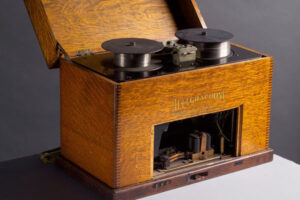The forgotten video cassette was once a revolutionary piece of technology that had a profound impact on domestic life. It sparked a cultural phenomenon and forever changed the way people consumed media at home. This blog post will delve into the rise and fall of the video cassette as a popular media format, exploring its early history and the lasting legacy it left behind.
Table of Contents
The Birth of a Revolution
The video cassette, which is now often forgotten, witnessed a remarkable journey that revolutionized the way people consumed media at home. Its early history and introduction to the market paved the way for a new era of entertainment. The video cassette was initially introduced in the 1960s and gained popularity in the 1970s as a convenient way to watch movies and TV shows at home. This inexpensive and portable format enabled people to enjoy their favorite films and series without having to go to the cinema or wait for them to be broadcasted on television.
The introduction of the video cassette was a game-changer for many families, as it provided a whole new level of convenience and flexibility in consuming media. Instead of being tied to the TV schedule, households could now watch their favorite shows and movies at their own pace. This new technology allowed people to pause, rewind, and fast forward through their videos, giving them complete control over their viewing experience. The video cassette, with its rewritable nature, also allowed users to record their own content, creating a personal library of films and programs.
The impact of the video cassette on the way people consumed media cannot be overstated. It brought the cinema experience into people’s living rooms and forever changed the dynamics of home entertainment. Suddenly, movie nights became a regular occurrence, as families and friends would gather around the TV to enjoy a rented video cassette together. The video rental stores became cultural phenomena, offering a vast selection of movies and creating a unique experience of browsing through the shelves of movie cassettes. This created a social bonding experience and added a sense of anticipation and excitement to the movie-watching process.
As the popularity of the video cassette grew, so did the demand for video cassette recorders (VCRs). These devices allowed people not only to watch pre-recorded content but also to record their favorite shows and movies directly from television. VCRs offered a level of convenience and control that was unparalleled at the time. Users could record shows while they were away or replay their favorite scenes over and over again. Television programming and viewing habits were forever changed, as viewers no longer had to adhere to strict schedules or miss out on their favorite shows.
The video cassette ushered in a new era of home entertainment that fundamentally transformed the way people consumed media. However, as technology advanced, the video cassette began to decline in popularity. The advent of DVDs and digital formats started to replace the beloved cassette. Slowly but surely, video cassette sales declined and rental stores closed down, making way for a new era of streaming services and digital media consumption.
Nevertheless, the legacy and influence of the video cassette can still be felt today. Its impact on home entertainment paved the way for the convenience and accessibility we experience with streaming services. The ability to watch movies and shows on-demand, pause, rewind, and create personalized libraries all traces back to the time when the video cassette revolutionized the way we consumed media.
In conclusion, the birth of the video cassette brought about a domestic revolution in the way people consumed media. From its introduction to the market, it changed the way families and friends shared and enjoyed movies and TV shows at home. The convenience and flexibility of the video cassette, along with the rise of video rental stores and the popularity of video cassette recorders, transformed home entertainment forever. While the video cassette may be forgotten now, its legacy can still be seen in the streaming services and digital media platforms that have taken its place. It is important to remember and appreciate the impact of this now-forgotten technology on our modern entertainment landscape.
Video Rental Stores: A Cultural Phenomenon
Video rental stores were a cultural phenomenon that had a significant impact on society in the era of video cassettes. With their vast collections of movies, these stores became a hub for entertainment, creating a unique social experience for customers.
Browsing through shelves of movie cassettes was an exciting and thrilling activity that allowed people to immerse themselves in a wide range of genres and discover hidden gems. The vast selection provided by the stores offered something for everyone, from classic films to the latest blockbusters. The experience of physically holding and examining the movie cases added an element of anticipation and excitement to the movie night.
Moreover, renting videos from these stores became a culture in itself. Movie nights with friends and family were eagerly anticipated events, where everyone gathered around the television to enjoy a cinematic experience from the comforts of home. The ritual of going to the video rental store, selecting a movie, and returning home with a collection of tapes created a sense of anticipation and shared excitement.
The social experience of renting videos extended beyond the movie night itself. People would discuss their movie choices with friends, recommending titles and sharing their opinions. The video rental store became a place where film enthusiasts formed connections and engaged in conversations about their favorite movies. It was a space where people with different tastes in cinema could connect and bond over their shared love for film.
With the rise of digital media and streaming services, video rental stores gradually declined and eventually disappeared. However, the impact and legacy of these stores can still be felt today. The culture of movie nights and the joy of browsing through shelves of movies have found new forms through online streaming platforms. While the physical experience of holding a VHS tape may be gone, the thrill of discovering and discussing films with others still remains. Nostalgia for the video rental store era has sparked a resurgence of interest in collecting and preserving movie cassettes.
Overall, video rental stores were a significant cultural phenomenon that left an indelible mark on society. They provided not only a means of entertainment but also a sense of community and shared experiences. Despite their disappearance, they continue to shape the way we engage with movies today, reminding us to appreciate and remember this now-forgotten technology.
Video Cassette Recorders: A Game Changer
Video cassette recorders (VCRs) were a game changer in the world of home entertainment. Their popularity soared as they allowed people to record and replay their favorite shows and movies. The ability to capture live television and watch it at a later time was revolutionary, giving viewers control over their viewing schedule.
Before the advent of VCRs, viewers were restricted to the programming schedule set by television networks. This meant that if their favorite show aired at a time when they were unable to watch it, they would miss out. However, with the introduction of VCRs, viewers were no longer tied to the television. They could set up their VCR to record their favorite show and watch it later at their convenience.
The impact of VCRs on television programming and viewing habits was significant. Television networks had to adapt to the changing landscape and cater to viewers who were now able to record shows and skip commercials. This led to the introduction of technologies like time-shifting, where viewers could record a show while watching another, and the development of commercial-skipping features.
Moreover, VCRs also opened up a world of possibilities for movie lovers. With the ability to record movies, people could now create their own movie libraries. They could build a collection of their favorite films and rewatch them whenever they wanted. This not only saved viewers money, as they no longer had to buy or rent movies repeatedly, but also gave them access to a vast array of content.
The introduction of VCRs was truly a game changer. It empowered viewers, allowing them to take control of their television viewing experience. The impact on television programming was undeniable, with networks having to adapt to the changing habits of viewers. And for movie enthusiasts, VCRs provided a new level of convenience and access to a wide range of films. Even though the era of VCRs has come to an end, their legacy can still be felt today through the capabilities of streaming services and the ability to record and save content digitally.
The Demise of the Video Cassette
With the rise of new technologies, such as DVDs and digital formats, the era of the video cassette started to decline. These new formats offered improved picture and sound quality, as well as additional features like bonus content and interactive menus. As a result, video cassette sales began to plummet, and video rental stores faced a challenging future.
As more and more people embraced DVD players and digital streaming platforms, the demand for video cassettes diminished significantly. The convenience and accessibility of DVDs, with their smaller and more durable format, made them a preferred choice for many consumers. Additionally, the emergence of online rental services and the ability to stream movies and TV shows directly from the internet further contributed to the decline of video cassette sales.
The impact on video rental stores was devastating. Once bustling locations where people gathered to browse through shelves of movie cassettes, these stores gradually closed down as the demand for video cassettes declined. The thrill of stumbling upon hidden gems and the joy of discovering new releases became a thing of the past. The cultural phenomenon of going to the video store on a Friday night for a movie night with friends or family eventually faded away.
However, despite the demise of video cassettes and the closure of rental stores, there has been a recent resurgence of interest in this forgotten technology. Many enthusiasts and collectors have embraced the nostalgia associated with video cassettes. They appreciate the unique experience of watching movies on a VCR and the distinctive aesthetic of VHS tapes. With the popularity of vintage and retro trends, video cassettes have become sought-after items for those seeking a taste of the past.
In conclusion, the rise of DVD and digital formats led to the decline of video cassettes, causing video rental stores to close down. However, the nostalgia and resurgence of interest in video cassettes demonstrate the lasting impact this forgotten technology has had on home entertainment. It is important to remember and appreciate the role video cassettes played in revolutionizing the way people consumed and enjoyed media at home.
Legacy and Influence
The legacy of the video cassette on home entertainment is undeniable. It revolutionized the way people consumed media at home, and its influence can still be felt today in the streaming services and digital media that have taken its place.
Before the advent of video cassettes, watching a movie or a TV show was a scheduled event. You had to catch it when it aired or wait for a rerun. But with the introduction of video cassettes, people could easily record and replay their favorite shows and movies. This gave them the power to control their entertainment, transforming the way they consumed media.
The widespread adoption of video cassette recorders (VCRs) allowed people to create their own personal libraries of films and shows. The emergence of video rental stores also contributed to the cultural phenomenon surrounding the video cassette. These stores created a sense of excitement as people browsed through shelves of movie cassettes, searching for the perfect film for their movie night.
But the rise of DVD and digital formats eventually led to the demise of the video cassette. Sales declined as people embraced the convenience and higher quality of these new technologies. Rental stores, once a staple of every neighborhood, closed down one by one.
However, despite its decline, the video cassette left a lasting mark on home entertainment. The concept of owning and curating a collection of films and shows became deeply ingrained in our culture. And while the physical cassette itself may have become forgotten, its influence can still be seen in the way we consume media today.
Streaming services like Netflix and Amazon Prime have effectively replaced the video rental store, allowing us to access a vast library of content from the comfort of our own homes. The ability to rewind, fast forward, and pause, features that were introduced with the video cassette, are now taken for granted in digital media.
In conclusion, the video cassette was a domestic revolution that forever changed the way we enjoy entertainment at home. Its influence can still be felt in the streaming services and digital media we use today. While it may be easy to forget the significance of this now-forgotten technology, remembering and appreciating the impact of the video cassette reminds us of how far we have come and the role it played in shaping the way we consume media.
Conclusion
The rise and fall of the video cassette marked a significant revolution in domestic life. This once-popular media format transformed the way people consumed content at home, revolutionizing the concept of home entertainment. With its introduction to the market, the video cassette quickly gained popularity, allowing individuals to watch their favorite movies and television shows at their convenience.
Video rental stores became a cultural phenomenon, offering a wide selection of movies for people to browse and rent. The thrill of exploring the shelves filled with movie cassettes added to the overall experience, creating a sense of anticipation and excitement. Movie nights, complete with rented videos, became a popular social activity, bringing families and friends together to enjoy a shared experience.
Video cassette recorders, or VCRs, were a game-changer in the industry. They let people record and replay their favorite shows and movies, giving them control over their viewing habits. This newfound flexibility had a profound impact on television programming, as people could now watch their preferred content on their own schedule. The rise of VCRs also brought about a change in viewing habits, with individuals no longer limited to the traditional television schedule.
However, despite its immense popularity, the video cassette eventually faced its demise. The rise of DVD and digital formats marked a shift in the industry, leading to a decline in video cassette sales and ultimately the closure of many rental stores. As technology advanced, the convenience and higher quality of these new formats eclipsed the appeal of video cassettes.
While the video cassette is now a forgotten technology, its legacy and influence can still be felt today. The concept of home entertainment, influenced greatly by its introduction, continues to shape how we consume media. Streaming services and digital media platforms, which owe their existence to the video cassette, provide a wide range of content at the touch of a button.
In conclusion, the video cassette brought about a domestic revolution, changing the way people consumed media at home. Its significance should not be forgotten, as it paved the way for the technologies we have today. Rediscovering and appreciating this now-forgotten technology is a way of honoring its impact on our lives and recognizing its role in shaping the modern world of entertainment.




